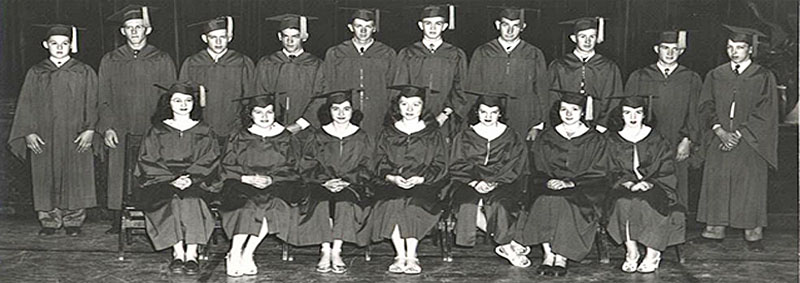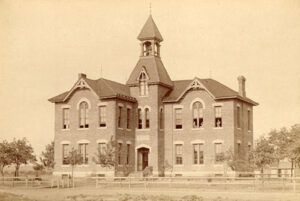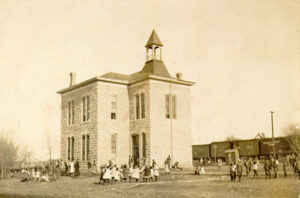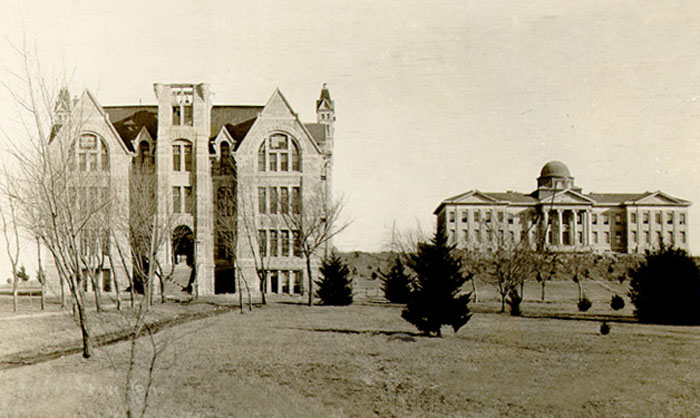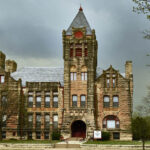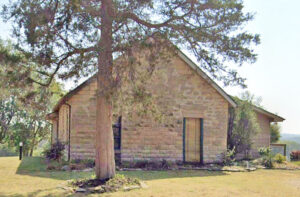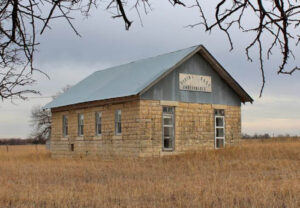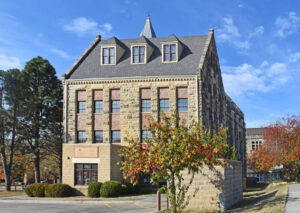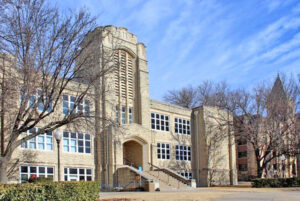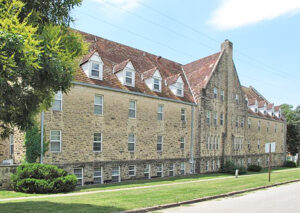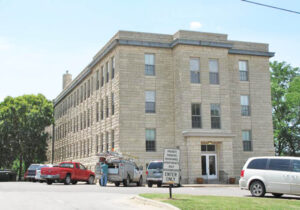In the winter of 1869-70, Cowley County, Kansas was first settled. Very soon, steps were taken to organize schools. Governor James Harvey organized the county in 1870. In November of the same year, L.B. Waumsey was elected county Superintendent of Schools, and the following winter, he died. E. P. Hickok was appointed to fill the vacancy. District No. 1, including Winfield, and District No. 2, including Arkansas City, were organized the following spring. In 1871, 37 districts were organized, with a school population of 659, an enrollment of 122, and an average daily attendance of 70 for the whole county.
The schools were taught in various buildings as could be secured. The first school in Rock Township was taught in the claim house of Frank Akers, which measured 12×14 feet, was built of green hackberry, and had a roof and floor of the same. As the boards seasoned, the cracks between them opened to an inch and a half. The roof was not waterproof, and the strips caused the sun’s rays to reflect upon the heads of the sweltering students within. The building had no windows, and the doors were not hinged, so when storms approached, they were held in place over the apertures by a prop. The furniture comprised blocks that were sawed to the length of stovewood and placed upon the end at proper intervals supported planks fresh from the sawmill. Such were seats. The teacher sat on one of the blocks, making up their record of the day with his register on their knees. This little room accommodated 42 students, and the spirit of improvement was so earnest that absence and tardiness were hardly known.
In 1872, there were 77 organized districts and 16 schoolhouses, many neatly built and well-furnished. In 1875, there were 108 districts, with 58 schoolhouses; in 1880, 125 districts, with 108 schoolhouses; in 1890, 150 districts and 150 schoolhouses, having 175 rooms, with belongings, all valued at $126,450, employing 191 teachers, enrolling 6,590 scholars, expending for the support of schools, $70,000. This was exclusive to the two cities of the second class.
The first normal institute was held at Winfield in August 1877. At the same time, the holding of institutes was an experiment; 76 of the 148 teachers in the county enrolled in the first session. It was conducted by L.B. Kellogg, with G. W. Robinson, Ella Wickersham, and George H. Buckman as instructors. Afterward, Cowley County held its regular annual institute. The sessions were usually well attended, with about 200 enrolling. In 1888, the enrollment reached 251. All the sessions were held in Winfield except for one in 1891, in the new high school building in Arkansas City.
Arkansas City Schools – In 1871, on the picturesque peninsula between the Walnut and Arkansas Rivers, Arkansas City was founded, and scarcely were the streets defined and locations determined when the attention of the intelligent and energetic homemakers was turned to providing means of instruction for the children that were to inhabit the new city. Miss Lizzie Swartz presided over the first school in this section in her log claim house in a part of the city.
In June 1871, School District No. 2 was organized, and steps were taken to erect a schoolhouse for $400. A wooden structure of one room was erected on the west side of South Summit Street, which was quite a neat affair for its time. Here, Thomas A. Wilkinson, the superintendent of schools, began the winter term of 1871-72. During the summer of 1872, Miss Collins taught the village school in the old wooden building, but after that term, the school became too large to be managed by one teacher.
During the first years of settlement, comparatively few children were among the settlers, as many who came to the frontier were young men searching for homes. In 1878, there were only 207 children of school age in the district, but 143 of these were enrolled in the schools, and the average daily attendance was 73; but, in the decade that followed, the number grew. In 1888, the school population was 2,271, the enrollment was 1,464, and the average daily attendance was 1,341. In 1890, there were 2,528 children of school age, and the enrollment was 1,848, with an average daily attendance of 1,231; while 1892 showed the school population was 2,800, and the enrollment was 2,100.
No improvements in the buildings were made until 1874 when the first-ward building was erected for $10,000. In 1885, the old building, with its two primary rooms on the same site and basement, was inadequate to accommodate the rapidly increasing population, and the fourth-ward building was erected for $10,000. As soon as it was finished, it was crowded to overflowing, and, during the following year, the second-ward building was erected, costing, with the grounds, nearly $9,000. In 1887, the third-ward building was erected, and the stone building in the fourth ward was enlarged; the two cost $25,000. In 1888, the old first-ward building was enlarged and improved, with heating and ventilation being supplied.
In 1890, a new high school building was erected at a cost, with its environments, of $38,000. In point of architectural design, taste, and neatness of finish, it is amongst the best in Kansas. Its elegant chapel seated 600 in opera chairs; its blackboards were of superior stone slate; and its recitation and study rooms accommodated 450 students. In the spacious hallway was a foundation of bright, pure water, about which was a collection of plants. In the basement was a roomy laboratory with modern conveniences for heat and water. The offices of the board of education and superintendent were finished in hardwood and marble, furnished with upholstered furniture, and neatly carpeted. It is heated throughout and was supplied with a fine library and the most approved apparatus.
It was the good fortune of Arkansas City to have an efficient school board. While it was only a school district, the men who managed its affairs were fully alive to the demands of the time, and since the organization of the Board of Education, nothing was neglected or overlooked that meant the improvements of the schools. During these years, many of the busiest citizens sat on the board. They gave cheerfully of their valuable time, with no hope of reward save that of seeing the educational interests of the community well administered. During the time of active building, the president of the board, Major L. E. Woodin, and the clerk, Mr. A. Wilson, gave much time and personal attention to the erection and improvement of buildings. The officers were enthusiastic schoolmen and left nothing undone to secure the best results for the annual expenditure of nearly $30,000. At that time, were were 33 rooms, employing 35 teachers besides the superintendent. The school year was usually nine months, of four weeks each.
These elegant surroundings were in striking contrast with the humble conditions of 20 years ago, and the pittance paid to Miss Swartz for her services bears a curious ratio to the $24,000 paid to teachers in the year ending August 1, 1890.
Winfield Schools – Hardly had the echoes of the axe of the first settler of 1869 died away when the public-spirited citizens of Winfield set about establishing a school where their children might enjoy the education facilities. A structure 20×30 feet and 20 feet in height, consisting of two stories, was erected by the citizens from logs cut from the trees growing along the Walnut River. This building served a variety of purposes, including Sunday church services. The upper room of this building was used for a private school during the summer of 1870, being presided over by Miss Anna Marks, later one of the leading teachers of the county. Her work was marked by earnestness and thoroughness. Reverend Parmelee of the Congregational Church followed Miss Marks, teaching during the week and preaching on Sunday.
In the spring of 1872, bonds were voted toward the erection of a substantial stone edifice 36×36 feet for $10,000, consisting of two spacious rooms, which did not meet the demands of the rapidly growing population. Later, the long, low building, familiarly known as the “barracks,” was built to accommodate the children of the primary grades. The basement of the Presbyterian Church was also used for school purposes.
When the place to build the schoolhouse was chosen, many protested against its location, as it was considered too far “out upon the prairie,” most of the residences were west of Main Street. Notwithstanding these objections, the leaders, with keen foresight, saw a bright future for the city and proceeded to erect on the chosen site the building that constituted the north wing of the handsome structure, which became the central building. Reverend E.P. Hickok was employed as principal during the fall and winter of 1871-72 and continued to fill the place very efficiently until his resignation in 1875. A. B. Lemmon, afterward State Superintendent of Public Instruction, succeeded him. W.C. Robinson taught in 1876-77. G.W. Robinson taught in 1878-79, at which time there were 510 children of school age, 385 enrolled, and an average attendance of 230. In 1887, there were 1,693 students of school age, 1,311 enrolled, and an average daily attendance of 884. E.T. Trimble became principal in 1880, remaining until 1884. Ansel Gridley, jr., was his successor, who remained until his removal to Harper. J. H. Hays followed him, remaining until 1891. The present principal, J. W. Spindler, began work in the fall of 1891. The remarkable growth of the schools in the previous 20 years could be better understood by comparing the number of students of the earlier and later dates. In 1870, the students numbered less than 40, with an attendance of 30. In 1892, the total enrollment was 1,390, with an average attendance of 984.
The fine stone structure in the first ward is known as the Central school building and, with the grounds, occupied a block. The latter were covered with beautiful greens and ornamented with various trees. The total cost, with grounds and buildings, was $25,000. In the remaining wards, the expenditure was sufficient to make the entire school property of the city worth over $60,000. The high school room was located in the Central building and had a seating capacity of 120. In 1893, the enrollment was 91. There were 14 rooms in the central building and 10 in the other wards, making 24 rooms and employing 27 teachers. The Central building was provided with a well-equipped library of 400 volumes, carefully selected to meet the needs of high-school students. Afterward, the school board appropriated money from the tuition of nonresident students to replenish the library and purchase philosophical and chemical apparatus, plus globes, maps, and models for drawing. A plan adopted by Superintendent J. W. Spindler for the advancement of teachers held meetings on the last Saturday of each month. A course of study for teachers had been previously assigned, and several teachers were chosen to prepare for the subjects studied. Discussions followed, and suggestions were made relative to the regular school work.
Southwest Kansas College – At its March session, 1885, the Southwest Kansas Conference determined to locate a college somewhere upon its field, appointed a board of trustees and a committee on location, and announced its readiness to receive proposals from towns desiring the location. Winfield immediately became an active competitor for the location. On the proposition that 40 acres of land should be given for the site, $60,000 for the erection of a building, and an annuity of $2,000 for two years for the support of faculty, Winfield was chosen. In the summer of 1886, the foundations of the main building were laid, and plains were made for the opening of the school. Reverend John E. Earp, D. D., of Indiana, was elected president of the institution, and the first term opened in September. The attendance was far beyond the trustees’ expectations and was phenomenal for a new institution. The following winter and spring, the main building was completed and furnished. Near the college was a commodious three-story dormitory for ladies, and in a pleasant grove adjoining the campus was the president’s residence, a comfortable home. It graduated its first class of three in June 1889.
In 1890, Reverend M. E. Phillips, D. D., was elected to succeed Doctor Earp, and within two years, the growth in attendance was all that could be desired, the net enrollment for 1891-92 being 513. There were 13 teachers employed, and, for a relatively new institution, it ranked high with a steady increase of students, and its moral and religious, as well as educational influence, became a stronger factor among those associated with it and in its immediate community.
Today, the private Methodist college is called Southwestern College. Traditional-aged students are housed and educated on a wooded 85-acre site with 20 buildings. The curriculum and extensive co-curricular activities are designed to prepare Southwestern’s graduates for leadership with its forward-thinking approach to technology. Working adults of all ages complete college degrees through the Professional Studies program. Graduate degrees are offered both on the main campus and through Professional Studies, with the college enrolling its first doctoral students (Doctorate in Educational Leadership) in 2012.
Cowley College – This public community college in Arkansas City, Kansas, held its first classes on September 11, 1922. At that time, it was known as the Arkansas City Junior College and, like most junior colleges of the time, operated under the directorship of the local school district. Classes were initially held on the top floor of the Arkansas City High School but were soon relocated to the basement, earning it the nickname “Basement University.” In 1936, a combination auditorium-gymnasium was constructed, and in 1952, the school held its first classes in a dedicated college building.
During the mid-1960s, it began a process of name changes to keep current with state legislation designed to spur the growth of junior colleges and vocational schools in Kansas. After no less than two revisions, in 1965, it was given the name Cowley County Community College and Vocational-Technical School.

The 1890 high-school building, now Ireland Hall, at Crowley Community College in Arkansas City, Kansas. Photo by Carol Highsmith.
The college’s main campus is in Arkansas City, Kansas. It also operates locations in nearby Winfield, Mulvane, Wellington, and Wichita. In addition to its online presence, the college offers on-site courses at nine area high schools. Cowley College’s Ireland Hall was designed by architect Charles Sumner Sedgwick and constructed in 1890 as the Arkansas City High School. It is listed on the National Register of Historic Places as Old Arkansas City High School and is considered one of the oldest standing buildings in the city.
Today, Cowley County is comprised of five school districts.
Arkansas City USD 470 is a public unified school district headquartered in Arkansas City, Kansas. The district includes Arkansas City, Parkerfield, Silverdale, and nearby rural areas. The district operates the Arkansas City High School, Arkansas City Middle School, Adams Elementary School, C-4 Elementary School, IXL Elementary School, Jefferson Elementary School, Roosevelt Elementary School, and Frances Willard Elementary School.
Central USD 462 is a public unified school district headquartered in Burden, Kansas. The district includes the communities of Burden, Atlanta, Cambridge, Grenola, Wilmot, and nearby rural areas. The school district operates the Central Jr/Sr High School and Central Elementary School.
Dexter USD 471 is a public unified school district headquartered in Dexter, Kansas. The district includes the communities of Dexter, Maple City, and nearby rural areas. It operates the Dexter K-12 School.
Udall USD 463 is a public unified school district headquartered in Udall, Kansas. The district includes the communities of Udall, Rock, and nearby rural areas. The school district operates the Udall Middle/High School and Udall Elementary School.
Winfield USD 465 is a public unified school district headquartered in Winfield, Kansas. The district includes the communities of Winfield, Akron, Floral, Hackney, New Salem, Tisdale, and nearby rural areas. The school district operates the Winfield High School, Winfield Middle School, Country View Elementary School, Irving Elementary School, Lowell Elementary School, Whittier Elementary School, and Early Learning Center for preschoolers.
Historic Schools of Cowley County
| Name | District | Years of Operation | Location & Information |
| Arkansas City | ?? | ?? |
Located at 300 W. Central Avenue in Arkansas City, Kansas, this three-story Romanesque Revival building began to be built in July 1890 and was occupied in September 1892. In 1922, the high school moved to a new building, and this one was then a sixth-grade center until elementary schools absorbed the sixth grade in 1941. It was listed on the National Register of Historic Places in 1974. It is now known as Ireland Hall, part of the Cowley Community College campus. |
| Bryant | ?? | 1880-1964 |
First constructed in 1880 for Winfield’s second or westward, the Bryant School is the only extant school building illustrating the town’s earliest public education history. As the town’s population grew, the school building was expanded to include additional classroom space, first in 1916 and then in about 1922, when a separate elementary building was constructed on the north side of the parcel. The primary school building was again updated in 1938 to accommodate better circulation and the building’s first indoor restrooms. The Bryant School continued to serve the children of western Winfield until 1964. By the end of the 1960s, this was the home of the Cowley County Historical Society Museum, which continues to own and operate it today. The school complex is significant for its association with Winfield’s public education history and its local architectural significance as an example of the City Graded School. It was listed on the National Register of Historic Places in 2017. It is located at 1011 Mansfield St. in Winfield, Kansas. |
| Olive School | 127 | ?? |
This stone and wood-frame school has been turned into a residence. It is located at 15384 85th Road near Winfield, Kansas. |
| District #57 | 57 | 1900-?? |
This one-story vernacular-style rectangular stone school with a gable roof was built in 1900. It is located at 34532 82nd Road, in the Grand Summit vicinity.
|
| St. John’s Lutheran College – Baden Hall | NA | 1894-1986 |
Baden Hall, once part of St. John’s Lutheran College, was built in 1893-1894. Founded by John P. Baden, one of Winfield’s prominent 19th-century businessmen, St. John’s was distinguished as one of two private, denominational colleges in the city. Baden Hall was constructed as the original facility at St. John’s – the only one associated directly with Baden himself – and, for 20 years, it was the sole building on the campus. The building’s function evolved from the primary classroom and dormitory space on campus to administrative offices. The college ceased operations in 1986, and since then, most of the buildings have been adaptively reused by the City of Winfield for various purposes. Today, the building serves as an apartment building. It was listed on the National Register of Historic Places in January 2011 for its significance as a prominent local educational facility. The Romanesque-style building is located at 619 College Street in Winfield, Kansas. |
| St. John’s Lutheran College – Meyer Hall | NA | 1923-1986 |
Once part of St. John’s Lutheran College, Meyer Hall was used as a chapel and education building. The school began operation in 1893 under the English Evangelical Lutheran Synod of Missouri and Other States and ceased operation in 1986 after over 9,000 students had been through its programs. Built in 1923, the three-story building has a flat roof and parapet. The exterior walls are rough-cut natural stone blocks. The windows are rectangular with sliding wood frames. The lintels and sills are smooth-cut natural stone slabs. Smooth stone capping along the roofline. Major features include the main entrance in an arch directly under a bell tower in the middle of the south wall and the detailed stonework. In 1988, the City of Winfield purchased the campus and renamed it Baden Square, and efforts began to utilize each building. The City completed the renovation of Meyer Hall in January 2000. Each of the three floors was gutted, and new common areas, elevators, accessible entrances, and restrooms were built. Capper Foundation is the anchor tenant, leasing nearly 10,000 square feet for office and activity rooms. Winfield Community Theater held its first production in the newly restored auditorium in June 2003. |
| St. John’s Lutheran College – Mundinger Hall | NA | 1950-1986. |
Mundinger Hall, once part of St. John’s Lutheran College, served as a girls’ dormitory. It was constructed in two phases between 1950 and 1953. It was listed on the National Register of Historic Places in January 2002 for its significance with its association with education and architecture. After the school closed in 1986, the three-story stone Late Gothic Revival building was renovated into apartments. It is located at 1315 E 6th Avenue in Winfield, Kansas. |
| St. John’s Lutheran College – West Dormitory | NA | 1915-1986 |
This rectangular four-story stone school was designed in the Late 19th & 20th Century Classical Revival with a flat roof with parapet. It was listed on the National Register of Historic Places in December 1991. One of the early St. John’s College buildings, this dormitory called Rehwinkle Hall is the second oldest surviving on campus and one of three buildings most closely associated with the college’s early history. Serving as Rehwinkel Hall Apartments today. It is located at 1415 E. 6th Street in Winfield, Kansas. |
©Kathy Alexander/Legends of Kansas, January 2024.
Also See:
Sources:
Historic Public Schools of Kansas
Kansas Historic Resources Inventory
Kansas State Historical Society, The Columbian History of Education in Kansas, Hamilton Printing Company, Topeka, KS, 1893.
Wikipedia

